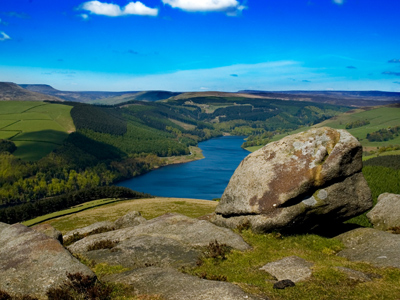
Ask the AI Tutor
Need help with Limestone Scenery 02? Ask our AI Tutor!
AI Tutor - Lucy
Connecting with Tutor...
Please wait while we establish connection

The Peak District has a large limestone area.
Limestone Scenery 02
This KS3 Geography quiz looks at British limestone. Discover how different limestone types formed, and why Carboniferous limestone creates some of our steepest cliffs, pavements and gorges.
1 .
Rainwater attacks limestone by which process?
Abrasion
Chemical weathering
Exfoliation
Physical weathering
Limestone dissolves in rainwater because rainwater is naturally slightly acidic
2 .
Which of these National Parks has the most extensive limestone area?
Dartmoor
Lake District
Peak District
Snowdonia
The Peak District is mainly in Derbyshire but extends into neighbouring counties
3 .
Why does a gorge floor contain lots of boulders?
From the collapse of a cavern roof
They were carried there by glaciers
They were deposited by streams
They were thrown by vandals
This can happen when a cave or cavern has formed close to the surface
4 .
On a diagram, limestone has what type of shading?
Brick wall
Circles
Cross hatching
Diagonal stripes
Because the rock is full of cracks like some brick walls
5 .
What are upright blocks in a limestone pavement called?
Brads
Clints
Grints
Tors
The gaps between them are called grykes
6 .
Gordale Scar in Yorkshire is an example of what?
A gorge
A limestone pavement
A stalactite
A swallow hole
It's approximately 15-16 million years old
7 .
Redeposited limestone rising from a cave floor has what name?
Dolomite
Kryptonite
Stalactite
Stalagmite
The largest of these can be millions of years old - they grow at a very slow rate
8 .
Lines of horizontal weakness between layers of limestone are called what?
Bedding planes
Carboniferous fissures
Rupture lines
Settling levels
Most sedimentary rocks have bedding planes
9 .
Which streams only appear on limestone after heavy rain?
Intermittent
Latent
Misfit
Sub-continuous
They will only appear when there has been a lot of rain. Some are seasonal and disappear in the summer, like the river Manifold on the border of Derbyshire and Staffordshire
10 .
Limestone areas often have which economic activity?
Coal mining
Fishing
Forestry
Quarrying
The rock has many uses e.g. building, in steelworks, making toothpaste
**Unlimited Quizzes Await You! 🚀**
Hey there, quiz champ! 🌟 You've already tackled today's free questions.
Ready for more?
Ready for more?
🔓 Unlock UNLIMITED Quizzes and challenge yourself every day. But that's
not all...
not all...
🔥 As a Subscriber you can join our thrilling "Daily Streak" against other
quizzers. Try to win a coveted spot on our Hall of Fame Page.
quizzers. Try to win a coveted spot on our Hall of Fame Page.
Don't miss out! Join us now and keep the fun rolling. 🎉
**Unlimited Quizzes Await You! 🚀**
Hey there, quiz champ! 🌟 You've already tackled today's free questions. Ready for more?
🔓 Unlock UNLIMITED Quizzes and challenge yourself every day. But that's not all...
🔥 As a Subscriber you can join our thrilling "Daily Streak" against other quizzers. Try to win a coveted spot on our Hall of Fame Page.
Don't miss out! Join us now and keep the fun rolling. 🎉






